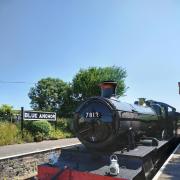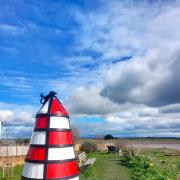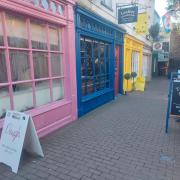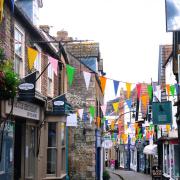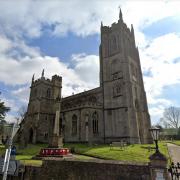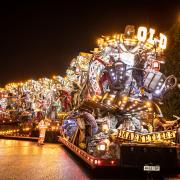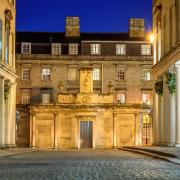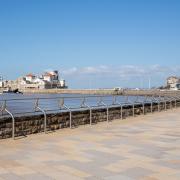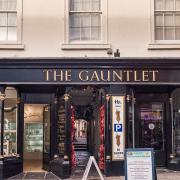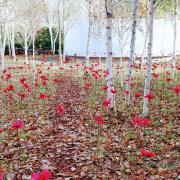In Chard they tell us of artificial limbs, astronomy and a whole lot more

Every plaque does indeed tell a story, either of someone famous, a local worthy, or a building we should admire. I sometimes wish today's folk would heed these windows into the past and stop staring at ubiquitous smartphones.
I arrived in Chard one sunny evening, a stopover on a helter-skelter tour of Somerset football grounds, Arthurian legends, and tales of Alfred the Great. It's amazing how much there is in this beautiful county. As soon as I caught breath in Chard, I realised I'd stumbled across something very special. It would be a story of lace, nonconformists, powered-flight, artificial limbs, astronomy and the odd cabinet minister.
Lots of towns have plaques. In Chard someone has put some thought into it, for there are 18 of identical appearance. They were conceived by 'Chard 2000' and are listed in the Chard Town Historic Plaque Trail (complete with map), which I garnered at the TIC in the Guildhall (Fore Street).

Chard is about more than plaques though. At 400ft up, this is the highest town in the county. The attractive main street is a mile long, possibly dates back to Roman times and has many sumptuous buildings, including that Guildhall (aka the Town Hall).
Then, there's John Stringfellow (1799-1883), credited with Britain's first powered-flight, albeit an unmanned, steam-powered monoplane. I guess we could term it a 'model'.
He worked in Chard, making bobbins for the lace industry, and his plane was built in a disused factory in the town. In Fore Street I found two plaques commemorating his achievement and a bronze model of his contraption. I soon found, however, that lace pervades Chard's story even more than 'magnificent men in their flying machines'.

The town grew firstly as a tanning centre in the 13th century, then as a weaving centre in the 15th. When that industry declined around 1800, it was lace predominating. The town also has a strong nonconformist tradition and therefore sided with both Parliament in the English Civil War (1642-61) and Monmouth during the 'Pitchfork Rebellion' of 1685. Unsurprisingly, for anyone knowing their Somerset, the town is surrounded by farmland.
With limited time I decided to knock off as many plaques as I could, with apologies to any I didn't manage. The 'trail' leaflet starts in the main street close to the Guildhall and takes you in numerical sequence from 1-18. As is my wont (for I am nonconformist) I opted for randomness.
I began at '11' (High Street School), purely because it was up my end of town (my bivouac the night before). This was the site of a nonconformist British school built in 1854. Having been enlarged by the school board in 1870, it later became a junior school between 1925 and 1960. A former pupil was one Margaret Bondfield, who I knew I'd heard of. The school is no more, having been demolished, so the plaque is on a stone wall, once forming its boundary.

Harvey's Homes, a bit further up the High Street, recalls Richard Harvey, who was born in Chard and left the property in his will of 1663 (a dozen years after the Civil War). The building was rebuilt in 1842 as a hospital, which became almshouses. It's a finely gabled and 'chimneyed' building, with the plaque inside the porch.
Arriving at Combe Street on the left, I headed down here to see two more plaques and their attendant buildings. Hope Terrace is an imposing one laid out by local philanthropists, led by the Reverend John Gunn (1789-1836), as they aimed to relieve hardship caused by 1820s unemployment. Beyond is Prospect House, a large residence, set back from the road, with its plaque on the front boundary wall. It was constructed in 1728 as the home and workshop of James Gillingham (1838-1924), a pioneer in manufacturing artificial limbs. Gillingham, also a prolific photographer, had a thriving business once the railway arrived in Chard in the 1860s (suddenly a prosthetic was just a train trip away).
Back in the main street I found two plaques on one building on the corner of Holyrood and Fore Streets. A modern-looking building housing a pair of shops was once the site of both a Medieval chapel and a printing business where the Chard and Ilminster News was founded in 1874. Some old buildings have not survived, a fact the newspaper might have reported on in the past.
Crossing Fore Street and heading down Holyrood Street was essential for here is Chard's lace heritage. The Lace Mill Workshops made machinery and bobbins for the mills. This characterful building was rebuilt around 1906, then converted to town houses, shops and a café in 1999. The nearby Holyrood Lace Mill, occupied by the library and councils today, manufactured plain net between 1829 and 1964. For many years the owner was Col JW Gifford (1856-1930), who was both an astronomer and 'x-ray photography' pioneer.
Regaining the main street, I found myself at the Town Hall, built in 1835 and variously a butcher's, 'shambles', prison cell and fire station. This is Chard's stand-out building with pillars, porticoes, clock tower and cupola. It's worthy of its plaque. I noticed a second one, dedicated to Margaret Bondfield (1873-1953), who I remembered had attended the nonconformist school. She was the first woman cabinet minister in Britain, appointed Minister of Labour in Ramsay MacDonald's Labour Government of 1929-31. Margaret was born in Chard, the daughter of a lace worker. Another lady commemorated next door (today's 'Boots'), was poor Lizzie Taff, sold for half-a-crown by her husband in 1801. We'd clearly come a long way by Margaret Bondfield's time.
I turned right up Boden Street to find the Boden Club & Institute, built in 1892 for mill workers, which later became a reading room and library, until 1998. It was nice to see workers being looked after. Retracing my steps to the main street, then continuing along Fore Street brought me to Holly Terrace (1896), one of several town 'rows', built for mill workers.
I started with a school and ended with one, Chard's Grammar School, which was founded in 1671, remaining here until 1890. The building is even older, dating back to 1583 when it was the house of a wealthy local merchant.
I didn't quite see all of the plaques, so my solution is simple; must return someday.




